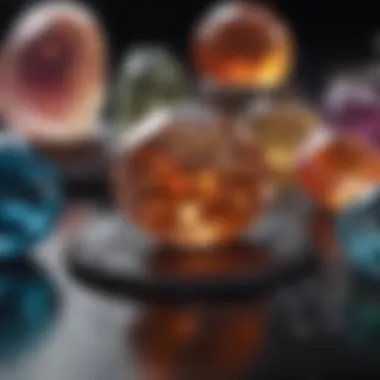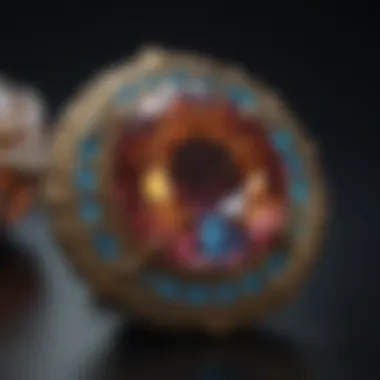Exploring the Allure of Glowing Gemstones


Intro
The world of gemstones captivates many individuals due to their intrinsic beauty and cultural significance. Among this category, glowing gemstones stand out for their unique luminescent properties. These stones not only dazzle the eye but also tell stories about their origins and have played diverse roles across various cultures. This article will guide readers through the detailed facets of glowing gemstones, their science, and how they continue to inspire admiration in contemporary times.
Gemstone Overview
Definition of Gemstones
Gemstones are naturally occurring minerals or organic materials that are cut and polished to create ornamental objects. They are typically valued for their beauty, rarity, and durability. Glowing gemstones, specifically, exhibit luminescence, an ability to emit light, often due to the presence of specific trace elements or structural characteristics.
Classification of Gemstones
Gemstones can be broadly classified into two categories: precious and semi-precious.
- Precious Gemstones : These include diamonds, emeralds, rubies, and sapphires. They are renowned for their hardness, brilliance, and rarity.
- Semi-Precious Gemstones : This group encompasses a wider variety, such as amethyst, aquamarine, and glowing varieties like fluorite or opal, which offers aesthetic appeal and diverse usages.
Glowing gemstones often enhance their value and appeal, drawing interest from collectors and jewelry designers alike.
Historical Significance
Origins of Gemstone Use
The use of gemstones dates back to ancient times. Early humans utilized stones for tools and adornments. As societies evolved, gemstones began to represent wealth and status. For instance, glowing gemstones were used in rituals and believed to hold mystical properties, enhancing their allure.
Cultural Insights: Gemstones in Ancient Civilizations
Various ancient civilizations recognized the significance of gemstones. In Ancient Egypt, gems were often placed in tombs, believed to offer protection in the afterlife. Meanwhile, in Asia, jade was valued not just for its beauty but also for its representation of purity and moral integrity. Glowing gemstones, in these contexts, were often linked to spirituality and the divine.
As we move further into the article, a deeper understanding of the scientific aspects of luminescence and the contemporary role of glowing gemstones will unfold.
Prolusion to Glowing Gemstones
Glowing gemstones have captivated attention for centuries. Their unique luminescent properties set them apart from ordinary stones. This section serves as a gateway to understanding these fascinating gems, outlining their definitions, characteristics, and historical significance.
Interest in glowing gemstones extends beyond aesthetics. They carry scientific intrigue and cultural relevance. Knowing more about their properties can enhance appreciation for these natural wonders. For collectors and jewelry designers, the allure comes not just from beauty but also from the rich narratives associated with each type.
In the following subsections, we will explore detailed definitions of glowing gemstones. We will also delve into their historical contexts, revealing how cultures have valued them through time. This foundational understanding sets the stage for deeper inquiries into the types of glowing gemstones and their various applications.
Definition and Characteristics
Glowing gemstones are defined by their ability to emit light, either through fluorescence, phosphorescence, or bioluminescence.
- Fluorescent gemstones glow only when exposed to specific wavelengths of light. Common examples include fluorite and diamond. Their glow stops immediately once the light source is removed.
- Phosphorescent gemstones, on the other hand, can store light energy and continue to glow for a duration even after the light source is gone. This is observed in stones like strontium aluminate.
- Bioluminescent gemstones are rarer. They can produce light through biological processes. An example is the organic material found in certain deep-sea natural settings.
The characteristics of these gemstones often include vibrant color shifts and a range of brightness levels. The glowing effect is dependent on their chemical composition and crystal structure.
Historical Overview
The history of glowing gemstones is rich and varied. Ancient civilizations often regarded these stones as symbols of power and wisdom. In many cultures, they were believed to possess mystical properties. For instance, Egyptians revered turquoise for its protective abilities.
Throughout the Middle Ages, a fascination with luminescent materials surged. Gemstones that glowed were believed to have divine connections. They were frequently used in jewelry worn by nobility.
During the Renaissance, the scientific inquiry into the properties of gemstones expanded. Scholars began to study the light-emitting behavior of these stones, leading to more understanding.


In modern history, glowing gemstones attract both collectors and scientists. Advances in technology now allow better analysis of their properties, fostering an ongoing interest in their unique attributes. Collectors appreciate both the rarity and the historical significance of these gems in various cultures.
A deeper understanding of their definitions, characteristics, and history not only enriches knowledge but also enhances the appreciation of glowing gemstones in today's context.
Types of Glowing Gemstones
Understanding the different types of glowing gemstones is imperative for anyone interested in this captivating realm. Each category showcases unique properties that enhance their appeal and desirability for collectors and jewelry designers alike. The significance of classifying glowing gemstones assists enthusiasts in recognizing how variations in luminescence occur, leading to more informed choices when it comes to selection and investment. The benefits of exploring these types range from appreciating their natural beauty to the potential for acquiring valuable pieces that may increase in worth over time.
Fluorescent Gemstones
Fluorescent gemstones are those that exhibit a visible glow under ultraviolet (UV) light. This type of luminescence occurs due to the absorption of UV rays, which causes certain minerals within the gemstone to emit light at longer wavelengths. Examples of fluorescent gemstones include diamonds, rubies, and opals. Their fluorescent qualities can enhance the color and overall allure of the stone.
The ability for a gemstone to fluoresce depends largely on its chemical composition. Many gemstones with trace elements like chromium or manganese exhibit strong fluorescence. Notably, certain pieces may glow in specific colors, creating striking visual contrasts in jewelry settings. As such, collectors often seek fluorescent gems, as they offer a unique twist to traditional stone choices, making them stand out dramatically in various lighting conditions.
Phosphorescent Gemstones
Phosphorescent gemstones exhibit a captivating characteristic: they can continue to emit light even after the light source is removed. This phenomenon occurs when the gemstone absorbs energy and slowly re-releases it over time. Examples of phosphorescent gemstones include some varieties of strontium aluminate and certain types of calcite.
Unlike fluorescence, which presents an immediate glow only when exposed to UV light, phosphorescence provides a sustained luminescent effect. This trait is especially intriguing for those in the field of gemstone collecting and design. Pieces that exhibit this property often become conversation starters. The duration and intensity of the glow can vary, creating excitement around the collection and appreciation of these gemstones.
Bioluminescent Gemstones
Bioluminescent gemstones are a rare and fascinating category. Unlike fluorescent and phosphorescent gemstones, bioluminescence is produced by living organisms, such as certain types of microorganisms. This gives these gemstones a unique charm, as they are often associated with natural processes. While not commonly found, some examples include specific types of organic materials, like fossilized resin, that can glow under certain conditions.
The allure of bioluminescent gemstones lies in their connection to nature and life. Collectors often find these pieces to be not just functional items but also fascinating examples of how life can leave a mark in geological history. Owning a bioluminescent gemstone conveys a unique experience. It bridges the gap between the mineral world and the vibrant life that thrives around us.
"Each type of glowing gemstone offers a glimpse into a natural world filled with wonder. Their varying properties provide a rich canvas for exploration and appreciation, solidifying their role in both modern jewelry and historical context."
In summary, the types of glowing gemstones encompass a diverse spectrum, each with its own scientific intricacies and aesthetic values. These distinctions help enthusiasts navigate their collections and educate themselves alongside others who share their passion.
The Science Behind Luminescence
Understanding the science behind luminescence is vital to appreciate the unique characteristics of glowing gemstones. Luminescence refers to the process by which certain substances emit light when they absorb energy. This phenomenon can take various forms, each contributing to the allure of these gemstones. The study of luminescence involves examining chemical properties, interactions of external energy, and the shimmering light that emerges as a result.
The significance of luminescence in glowing gemstones goes beyond aesthetics; it connects to their formation, location, and market value. For enthusiasts, comprehending these scientific aspects enhances the experience of ownership. Collectors, designers, and geologists all benefit from a deeper understanding of the mechanics behind these captivating effects.
Chemical Composition
The chemical composition of glowing gemstones is a key factor determining their luminescent properties. Fluorescent gems often contain specific minerals or trace elements that influence their ability to glow. For instance, the presence of manganese or rare earth elements can enhance fluorescence. Such minerals, when exposed to ultraviolet (UV) light or even just sunlight, trap energy temporarily and re-emit it as visible light.
Common gemstones like fluorite, diamond, and jade exhibit fluorescence, creating a stunning visual phenomena when viewed under UV light. Bioluminescent stones, on the other hand, possess organic compounds that allow them to emit light through biochemical reactions, which is entirely different from how traditional gemstones glow.
Key components in glowing gemstones include:
- Mineral content: Specific substances like iron or copper can impact luminescence.
- Defects within the crystal structure: These irregularities can act as activators for light emission.
- Environmental factors: Conditions such as temperature or pressure during formation may influence luminescent properties.
Mechanisms of Glowing
The functioning mechanics of glowing gemstones can generally be categorized into three main processes: fluorescence, phosphorescence, and bioluminescence. Each category represents a distinct interaction with energy sources.
- Fluorescence: This occurs when a gemstone absorbs UV light and immediately re-emits it as visible light. The glow persists only as long as the stimulating light is present. For example, under a UV lamp, a diamond may flash bright blue, yet without the light, it appears normal.
- Phosphorescence: This type of luminescence differs as it allows gemstones to store energy. After the excitation source is removed, these stones continue to emit light for a period, which can range from milliseconds to hours. This property is often observed in stones like sphalerite. Phosphorescent gemstones are fascinating due to their lingering afterglow.
- Bioluminescence: Though rare, some gemstones possess this captivating feature. They can produce light through chemical reactions, much like deep-sea organisms. This type of luminescence is less common in traditional gemstones and more often found in organic materials.
Understanding these mechanisms enriches the appreciation for glowing gemstones. Each process reflects the intricacies of nature’s design, tying together geology, chemistry, and aesthetics in a compelling narrative.
Luminescence connects beauty and science, revealing nature’s most intriguing secrets.


Cultural Significance of Glowing Gemstones
The allure of glowing gemstones extends far beyond their aesthetic appeal. Their cultural significance is deeply rooted in mythology, spiritual beliefs, and societal values. These luminous stones have captured the human imagination throughout history, prompting various interpretations and associations across different cultures. Understanding the cultural importance of glowing gemstones provides insight into their lasting impact on art, jewelry, and personal adornment, which enriches their value and appeal.
Myths and Legends
Many cultures have embedded glowing gemstones into their myths and legends. For example, the ancient Greeks thought that the fire opal had protective qualities. They believed it to bring strength and courage to those who wore it. Similarly, in Hindu mythology, diamonds were referred to as the "teardrops of the gods." The tales often revolve around themes of love, protection, and the supernatural. These stories serve not only as entertainment but also as a way to impart moral lessons and cultural identity.
Some regions have specific legends associated with certain gemstones. The legendary tale of the blue sapphire states that it can safeguard its wearer from envy and misfortune. Such narratives demonstrate how glowing gemstones are often considered potent symbols of hope and resilience, endowing individuals with a sense of purpose.
The belief in these legends continues to influence consumer choices in jewelry markets today. Many individuals still seek out gemstones not only for their look but also for their storied past, hoping to connect with the positive attributes associated with them.
Symbolism in Different Cultures
Glowing gemstones symbolize a multitude of characteristics depending on the cultures that revere them. For instance, in many Native American traditions, turquoise is thought to signify healing and protection. Similarly, in Chinese culture, jade represents purity and moral integrity. This rich tapestry of symbolism demonstrates how glowing gemstones have been intertwined with human values over centuries.
- Healing and Protection: Many cultures regard specific gemstones as powerful safeguarding amulets. For example, the amethyst is often believed to promote warmth and calmness.
- Wealth and Power: Some gemstones, like the emerald, are linked with prosperity. They symbolize fertility and prosperity in various cultures. This association can influence societal hierarchies, making these gemstones highly sought after.
- Love and Emotions: In Western cultures, the rose quartz is seen as a stone of love, symbolizing compassion and connection. Its popularity in romantic jewelry also demonstrates how glowing gemstones can transform personal relationships.
In summary, the cultural significance of glowing gemstones is layered deep within human history. Their myths and symbols echo across continents, influencing arts, jewelry, and personal identity. By understanding their significance, one can appreciate their role not just as ornamental stones but as vessels of cultural heritage.
Glowing Gemstones in Modern Jewelry
Glowing gemstones are not just geological curiosities; they have carved a niche in the jewelry industry. Their unique visual appeal and interesting characteristics make them popular among designers and consumers alike. As our world leans towards distinctive and expressive forms of self-presentation, the presence of these gemstones has become more pronounced in modern jewelry trends.
Design Trends
In recent years, jewelry designers have started to incorporate glowing gemstones into their creations. The vibrant hues and luminous effects of these stones facilitate innovative designs. For example, pieces featuring gemstones like fluorite and diamonds with phosphorescence lend an extraordinary quality to engagement rings or statement necklaces.
Designers are not just focusing on classic cuts and settings; instead, they explore unconventional forms and arrangements. The incorporation of glowing stones allows jewelers to experiment, leading to a rise in asymmetrical designs and mixed materials. There are also collections featuring glowing gemstones that are designed specifically to highlight their luminescent properties, perhaps under UV light. Such designs catch the eye and imbue pieces with captivating life at various times of the day.
Consumer Preferences
As consumers become more aware of the uniqueness surrounding glowing gemstones, their preferences are shifting accordingly. Today, buyers often prioritize originality over mass-produced items. Owning a piece that incorporates a glowing gemstone signifies a connection to nature's wonders, as well as an appreciation for artistry and craftsmanship.
The growing interest in eco-conscious fashion also influences consumer choices. They seek gemstones that align with sustainable practices. In this context, glowing gemstones offer a compelling narrative that many consumers wish to embrace. Whether it's the ecological extraction of these stones or the artisanal methods used to create the accompanying jewelry, transparency about sourcing and production plays a key role in attracting buyers.
"People want jewelry that tells a story, and glowing gemstones certainly contribute an enchanting chapter to that narrative."
In addition to ethical considerations, there is a fascination with the science behind luminescence. Consumers are eager to learn about the specific properties of gemstones they wear. This interest further fuels the market for educational content about glowing stones, encouraging jewelers to share insights about the materials, their origins, and the luminescent properties they exhibit.
As glowing gemstones continue to influence modern jewelry design and consumer choice, it is clear that these unique stones are not fading from popularity. Their power to engage and enchant remains integral to the evolving landscape of fashion.
Care and Maintenance of Glowing Gemstones
Glowing gemstones are not only visually appealing, but they also require special attention and care to maintain their luminescent qualities. Understanding the proper care and maintenance of these unique stones is essential for both collectors and jewelers. With specific cleaning and storage methods, one can preserve their beauty and value for years to come. This section discusses essential practices in caring and maintaining these precious gems.
Cleaning Methods
Maintaining the cleanliness of glowing gemstones is crucial, as dust and oils from handling can diminish their natural glow. Here are some recommended cleaning methods:
- Gentle Soap and Water Solution: A mixture of mild soap and warm water is one of the safest ways to clean gemstones. Use a soft cloth or brush to gently scrub the surface without causing scratches.
- Ultrasonic Cleaners: While many gemstones can benefit from ultrasonic cleaning, caution is needed. Some glowing gemstones might have unique properties that could be affected by this method. Always check if the specific gemstone is safe for ultrasonic cleaning.
- Avoid Harsh Chemicals: It is advisable to avoid anything abrasive or harsh. Strong cleaners can damage the stone and affect its luminescence.
"Regular maintenance not only preserves aesthetics but also supports investment value in the long term."
Storage Guidelines


Proper storage is just as important as cleaning for the longevity of glowing gemstones. The following guidelines can ensure that the gemstones remain in excellent condition:
- Use Soft, Separate Pouches: Store each glowing gemstone in a separate soft pouch to prevent scratches. This is particularly important for softer gemstones that can be easily damaged.
- Control the Environment: Keep gemstones in a stable environment, away from direct sunlight and extreme temperatures. UV light can degrade certain types of glowing gemstones over time, dulling their vibrancy.
- Avoid Humidity: Excess moisture can also damage gemstones, so a dry environment is ideal. Use silica gel packs in storage areas to manage humidity levels.
Investment Potential of Glowing Gemstones
Glowing gemstones present a unique opportunity for investment, setting them apart from traditional gemstones and collectibles. Their rarity, aesthetic appeal, and increasing market demand contribute to their status as a potential asset class. For investors, it is crucial to understand various aspects, including market trends, the unique properties of these gemstones, and how to evaluate their value.
Market Trends
The market for glowing gemstones has shown significant growth in recent years. Factors like the rising popularity of unique jewelry designs and the influence of social media are driving demand. The increasing interest among collectors and enthusiasts fuels this market. Key trends include:
- Sustainability: Many buyers are now more conscious of the environmental impact and ethical sourcing of gemstones. Glowing gemstones that are responsibly sourced are gaining traction.
- Artisanal Craftsmanship: Custom designs that highlight the luminescent properties attract clients. This trend is more pronounced in the luxury jewelry segment.
- Technological Influence: Online platforms and e-commerce have made it easier for buyers to discover glowing gemstones. Both virtual marketplaces and social media channels connect collectors and designers.
These trends indicate a growing niche market that presents long-term potential for investors. Understanding consumer preferences, especially in the context of glowing gemstones, can provide insight into where the market is heading.
Evaluating Value
Evaluating the value of glowing gemstones involves several criteria may differ from traditional gemstones. This includes:
- Origin: The location where the gemstone is mined can significantly impact its value. Some locales are more renowned for quality fluorescent or phosphorescent stones.
- Quality of Luminescence: Not all stones glow equally. The brightness, duration, and color of the glow are essential factors to assess.
- Rarity: The scarcity of specific gemstones often raises their value. Unique qualities—like an unusual color or pattern—also contribute.
- Certification: Gems that come with a certification from respected gemological laboratories are more likely to retain value. Authenticity plays a critical role in the investment potential of glowing gemstones.
In closing, an informed approach is paramount for potential investors in glowing gemstones. With a keen understanding of market trends and valuation metrics, investors can navigate this evolving market effectively.
"The allure of glowing gemstones lies not only in their beauty but also in their potential as valuable investments. Recognizing the nuanced market trends is essential for making informed decisions."
Examining the investment potential of glowing gemstones combines financial insight with an appreciation for the natural world. As this sector develops, it may become an essential area for both enthusiasts and investors.
Future Prospects for Glowing Gemstones
The future of glowing gemstones presents a blend of opportunity and innovation. As interests in unique materials continue to grow, these luminous stones are gaining recognition, not just for their beauty but also for their potential applications across various sectors. In exploring future prospects, a few critical elements emerge, including technological advances, market growth, and environmental considerations. Each of these aspects contributes to the evolving landscape surrounding glowing gemstones and their significance in the coming years.
Technological Advances
Advancements in technology are reshaping how glowing gemstones are processed and utilized. New techniques in gem synthesis and enhancement are being developed. For instance, laboratories are creating synthetic gemstones with similar glowing properties as their natural counterparts. This not only makes them more accessible but also offers a controlled environment for quality assurance.
Additionally, the integration of digital technologies allows for better analysis and categorization of glowing gemstones. Techniques like photoluminescence spectroscopy enable gemologists to study the properties of these stones more deeply. This enhanced understanding is crucial for determining their value and suitability for various applications, including art and jewelry design.
"Technological progress is fundamental in unlocking the hidden potential of glowing gemstones."
Moreover, online marketplaces and e-commerce platforms enhance the visibility and availability of these gemstones. Tools such as virtual reality and augmented reality allow consumers to explore without physical constraints, making glowing gemstones attractive to new buyers.
Environmental Considerations
The environmental impact of gemstone extraction, particularly in the context of glowing gemstones, cannot be dismissed. As public awareness of sustainable practices grows, consumers favor gem sources that demonstrate environmental responsibility. This shift compels gem producers to adopt more sustainable mining and sourcing practices.
A notable trend is the increase in recycled and lab-grown gemstones. These alternatives present ethical options without compromising the aesthetic character of glowing gemstones. Additionally, incorporating sustainable practices potentially reduces the carbon footprint associated with traditional gemstone mining.
In this chapter's context, glowing gemstones can lead the industry towards a more holistic and eco-conscious future. Their unique characteristics combined with sustainable sourcing make them appealing options for consumers who prioritize environmental responsibility.
Ensuring a balance between market demand and environmental stewardship will play a crucial role in shaping the future landscape of glowing gemstones.
Closure
The conclusion of this article serves a crucial role in consolidating the numerous insights discussed regarding glowing gemstones. It brings together the exploration of their types, the science of luminescence, and their significance in various cultures and modern jewelry. This synthesis allows readers to appreciate not just the aesthetic allure of these gemstones, but also their multifaceted value in society.
Understanding glowing gemstones goes beyond their captivating appearance. For gemstone enthusiasts, collectors, and jewelry designers, it is essential to recognize the underlying characteristics that make these stones unique.
Summary of Key Points
- Types of Luminescence: Various gemstones exhibit different types of luminescence, such as fluorescence, phosphorescence, and bioluminescence. Each type contributes distinctively to the jewel's charm and appeal.
- Scientific Basis: The mechanisms behind the glowing properties involve complex chemical compositions, which vary among different gemstones. This scientific foundation enhances the appreciation of their beauty.
- Cultural Impact: The historical and cultural significance of glowing gemstones adds depth to their allure. From myths and legends to symbolism in diverse cultures, these stones are woven into the human narrative.
- Contemporary Trends: The modern jewelry market continues to embrace glowing gemstones, as trends evolve to incorporate their unique properties. Consumer preference indicates a growing interest in these extraordinary materials.
- Future Potential: Technological advances and environmental considerations may shape the future of glowing gemstones, influencing both their availability and desirability.



